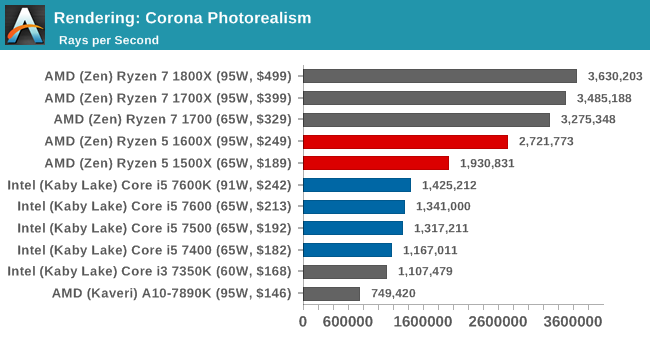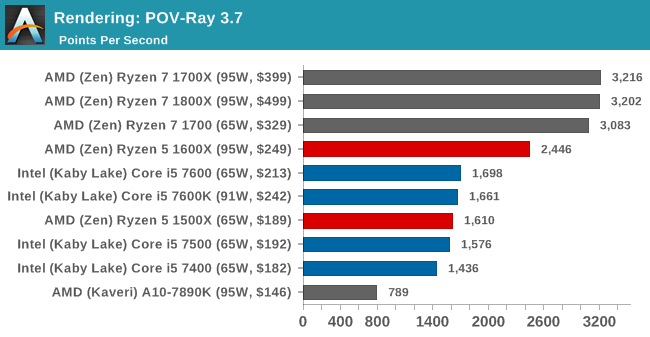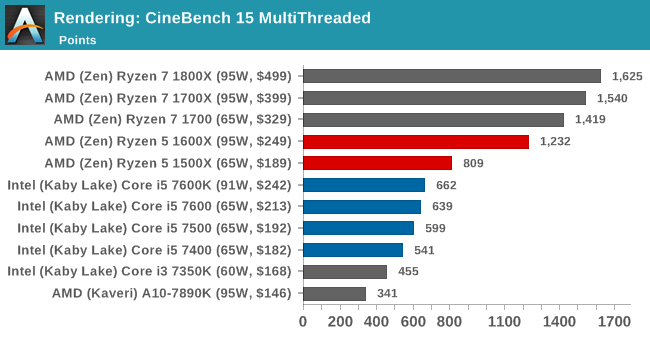The AMD Ryzen 5 1600X vs Core i5 Review: Twelve Threads vs Four at $250
by Ian Cutress on April 11, 2017 9:00 AM ESTBenchmarking Performance: CPU Rendering Tests
Rendering tests are a long-time favorite of reviewers and benchmarkers, as the code used by rendering packages is usually highly optimized to squeeze every little bit of performance out. Sometimes rendering programs end up being heavily memory dependent as well - when you have that many threads flying about with a ton of data, having low latency memory can be key to everything. Here we take a few of the usual rendering packages under Windows 10, as well as a few new interesting benchmarks.
Corona 1.3
Corona is a standalone package designed to assist software like 3ds Max and Maya with photorealism via ray tracing. It's simple - shoot rays, get pixels. OK, it's more complicated than that, but the benchmark renders a fixed scene six times and offers results in terms of time and rays per second. The official benchmark tables list user submitted results in terms of time, however I feel rays per second is a better metric (in general, scores where higher is better seem to be easier to explain anyway). Corona likes to pile on the threads, so the results end up being very staggered based on thread count.
Blender 2.78
For a render that has been around for what seems like ages, Blender is still a highly popular tool. We managed to wrap up a standard workload into the February 5 nightly build of Blender and measure the time it takes to render the first frame of the scene. Being one of the bigger open source tools out there, it means both AMD and Intel work actively to help improve the codebase, for better or for worse on their own/each other's microarchitecture.
POV-Ray 3.7.1
Another regular benchmark in most suites, POV-Ray is another ray-tracer but has been around for many years. It just so happens that during the run up to AMD's Ryzen launch, the code base started to get active again with developers making changes to the code and pushing out updates. Our version and benchmarking started just before that was happening, but given time we will see where the POV-Ray code ends up and adjust in due course.
Cinebench R15
The latest version of CineBench has also become one of those 'used everywhere' benchmarks, particularly as an indicator of single thread performance. High IPC and high frequency gives performance in ST, whereas having good scaling and many cores is where the MT test wins out.















254 Comments
View All Comments
Icehawk - Tuesday, April 11, 2017 - link
Good point, my company isn't going to spend more for an AMD system for our regular users and a video card (even junk) would likely tip the cost against them. I do think some of our devs might like these and there we can justify the extra $.Krysto - Wednesday, April 12, 2017 - link
Ryzen APUs are coming.deltaFx2 - Tuesday, April 11, 2017 - link
@jrs77: Talk about strawman arguments. "as the most used software is still singlethreaded " Just because you vehemently assert it doesn't make it true. All the MT workloads tested in Ian's suite are real workloads people use. I have 14 "Chrome Helper" threads running on my laptop as I type this, just to point out the obvious. The software that continues to be single threaded are the ones in which the cost of a MT implementation outstrips the gain. Office is 1T (I'll take your word for it) because it works perfectly fine on Atom or Excavator. I don't think Photoshop is a workload that holds up people most of the time either. Here's the other thing: Folks who have Photoshop for a living also likely do video editing, rendering and so forth. Sometimes at the same time as photoshop. See Ian's review of various workloads that do this.iGPU: That is fair point for the 4c part. For the hex-core, you're getting into the same usage space as the 8c: content creators. Then again, who buys desktops these days for office work? Most offices I know of give their employees laptops + docking stations. It's only gamers and content creators, CAD folks that buy laptops. These guys also buy graphics cards to go with their rig.
psychobriggsy - Wednesday, April 12, 2017 - link
One benchmark that used to be done was multiple apps at the same time.For example, a browser benchmark running alongside a video encode.
This can show real world use cases a lot better. Also it would show off better MT implementations better, in this case Ryzen would fare a lot better (either by having SMT in the 4C8T, or have more cores and SMT in the 6C12T) even where the Intel equivalent would do okay when doing 1 task only.
masouth - Wednesday, April 12, 2017 - link
to add onto that, even certain tools/ functions in Photoshop are multi-threaded. Most blurs are as well as color mode conversions just to name a couple.as usual, YMMV depending on how often you use those but it IS there and more cores/threads offers a very real benefit for people that do use them.
Meteor2 - Wednesday, April 12, 2017 - link
Most users could easily get by with Celerons. I'm not sure what your point is.ChubChub - Tuesday, April 11, 2017 - link
At $250 what should you get? A 1400, and use the extra cash + saved cash on the motherboard to get a better GPU.davide445 - Tuesday, April 11, 2017 - link
1600x or 1600 will be part of my new rig.Really clear from this review AMD does optimize his CPU for serious tasks (where lie the real lasting grow in the PC market) and modern gaming titles (DX12, the future), leaving a sufficient to good performance to the others.
Minimizing production costs can profit for sales and sustain Intel possible dumping activities.
IMHO a clever strategy, since they didn't need to serve ALL the market, but just being able to lead the most profitable, that's for sure not the casual e-Sport gamer.
ImperfectLink - Tuesday, April 11, 2017 - link
Cinebench 10 and 11.5 tables are mixed up. It's 11.5 first with the decimals and 10 with the thousands.farmergann - Tuesday, April 11, 2017 - link
You choose to finish the article with, "...the Intel CPU is still a win here." A sentence that simply doesn't belong in any Ryzen vs sky/kaby comparison, much less as the final statement. What a joke of a shill you must be. BTW, your own testing reveals that tasks and games truly dependent on single thread IPC find Broadwel DT the victor over newer intel garbage, yet you mention Broadwell here as though it were dated... pitiful.